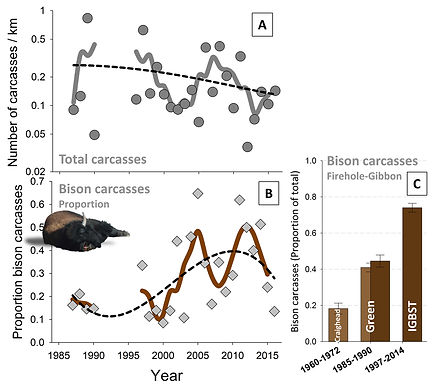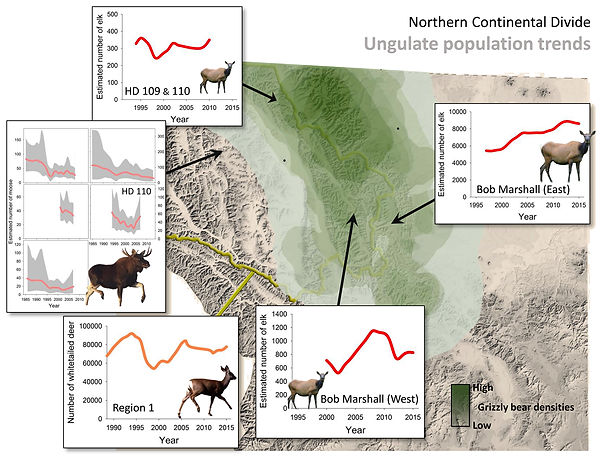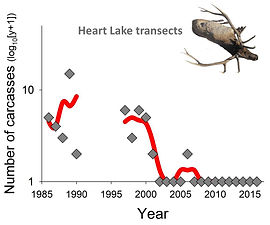
Mostly Natural
GRIZZLIES
Of the Northern Rocky Mountains
For everything on the politics and policy of grizzly bear conservation
go to Grizzly Times
For everything on the ecology of Ursus arctos, go to All Grizzly

Trends
in availability and consumption of meat by grizzly bears
It is perhaps trite to observe that grizzly bear diets vary in time and space as a function of food availability, comparative preferences for available foods, and the exigencies of optimizing diet nutrients--with additional differences introduced by the life strategies of male versus female and juvenile versus adult bears. All of these factors have affected--and continue to affect--consumption of tissue from large herbivores by grizzly bears in the northern US Rocky Mountains. The focus here is on recent decadal variations in consumption and availability of meat resources, noting that consumption by bears is not necessarily highly correlated with availability. Parenthetically, I cover longer-term trends spanning centuries, even millennia, under Paleohistory and Recent history of bison--the emphasis on bison arising from the fact that this species was probably uniquely important to grizzlies in central North America prior to arrival of Europeans and the resulting ecological holocaust (see also Scavenging and the Introduction).
Very few studies have tracked annual or longer-term variations in bear diets. More often long-term studies of bears have focused on monitoring population characteristics and abandoned investigations of diet and habitat use after only a handful of years. The reasons for this involve politics, prejudice, and logistics. Collection and analysis of feces or visual observations sufficient to capture annual variations in diet is labor intensive. However the emergence of methods that provide estimates of diet from the analysis of isotopes has allowed researchers to exploit information collected during the course of population monitoring, albeit historically only at the crude level of meat versus vegetation, terrestrial versus marine. With refinements, analysis of isotopes has provided increasingly higher resolution estimates of diet, but still rarely to the extent of allowing taxonomic identification of consumed foods. The upshot is only one study--in the Yellowstone ecosystem--that has tracked exploitation of different species of large herbivores by bears for an appreciable period of time, although several studies, including the one in Yellowstone, have provided longer-term crude estimates of meat consumption from analysis of isotopes.
The figure at left shows trends in consumption of meat from larger terrestrial mammals by Yellowstone grizzly bears using two different methods spanning a critically important period of time, 2002 to 2011. The top graph shows annually-averaged values for isotopes indicative of meat consumption extracted from blood clots collected from captured bears. The bottom graph shows relative levels of annual feeding on carcasses of large mammals inferred from telemetry locations of radiocollared bears. The size of the each brown dot is proportional to the size of the whitebark pine seed crop, another important bear food in the Yellowstone ecosystem that female grizzlies tend to preferentially use when available--the consequent expectation being that large dots would be below rather than above the trend line.
Results from both methods clearly show increasing consumption of meat during this period of time, especially, as it turns out, by female and adolescent grizzlies. This trend is important because it occurred following the functional extirpation of cutthroat trout as a bear food in the Yellowstone ecosystem, and concurrent with catastrophic losses of whitebark pine from an unprecedented outbreak of bark beetles. Almost certainly, grizzlies in the Yellowstone ecosystem were compensating for losses of trout and pine seeds by eating more meat. Unfortunately, neither source of information clarifies which species of large herbivores were being exploited, or where--highlighting the limitations of indirect measures versus more direct observations. And, paradoxically, this increasing consumption of meat by grizzlies was occurring during a time when most populations of native large herbivores were declining in the Yellowstone ecosystem (see immediately below).
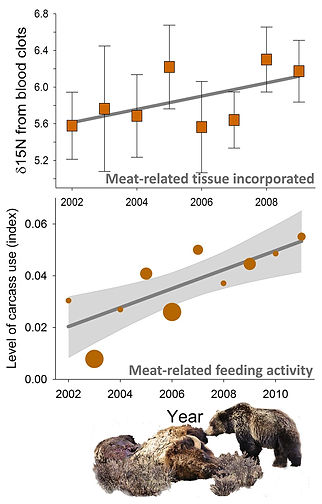
Trends in Consumption: Yellowstone
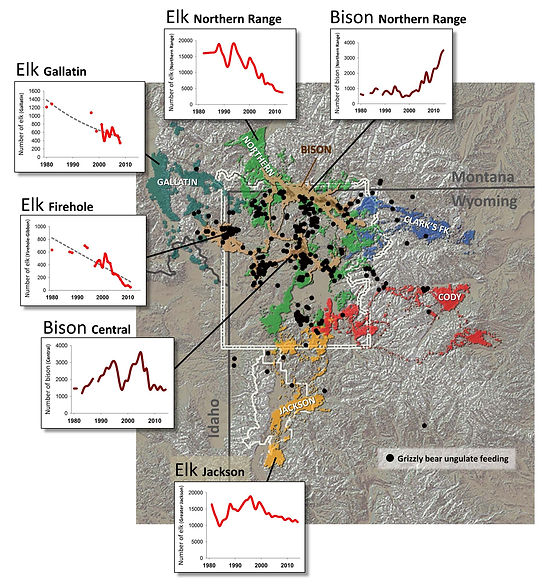
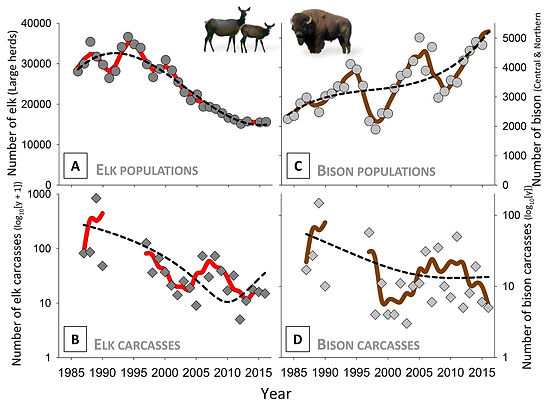
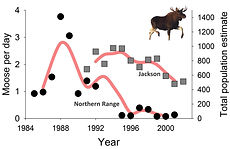
Trends in Availability: Yellowstone
The Yellowstone ecosystem benefits from having one of the most intensive on-going multi-jurisdictional efforts in the United States to monitor populations of ungulates. I exploited the fruits of these sustained efforts to produce the map and associated figures at right showing trends in not only populations of elk, bison, and moose, but also availability of carrion during spring on key ungulate winter ranges. Spring carrion is especially important because it provides a disproportional amount of the meat historically eaten by grizzly bears in the northern US Rockies (see Scavenging and Introduction). The map registers the core distributions of different elk herds in different pastel colors, and of bison herds in shades of brown. The black dots denote locations where grizzlies exploited ungulate carcasses during 1977-1993. The inset figures each show trend each for an ungulate population, referenced to the map, with main trends represented by 3-year running averages shown in pink (moose), red (elk), or brown (bison). Trends span 1980-2014.
In short, sizes of elk, bison, and moose populations in the Yellowstone ecosystem have varied dramatically during the last 30+ years, with the predominant trend being towards decreasing abundance, especially since the ealy- to mid-1990s in the case of elk and moose. Declines in the Northern Range, Gallatin, and Firehole elk and moose herds have been extreme, to the point of local extirpation in the Firehole. Bison populations have been more variable, but with substantial declines in the Central herd since the early 2000s. The only herd that has unambiguously and substantially increased during recent decades has been bison on the Northern Range.
The widespread declines in elk and moose populations beg for an explanation. My review factors governing elk population dynamics elsewhere suggests that declines in numbers of elk have been caused by sport hunting, deteriorating summer range conditions, and predation by wolves and bears. In fact, death rates of elk calves attributable to bear predation have tripled since the 1990s, consistent with bears in the Yellowstone ecosystem relying more on meat for energy and nutrients with declines in other foods.
